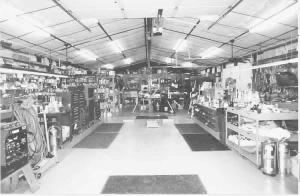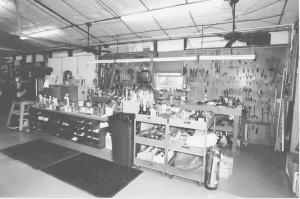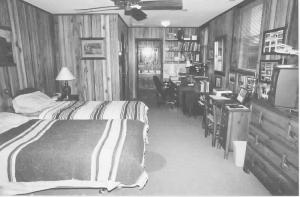2004 - Volume #28, Issue #4, Page #39
[ Sample Stories From This Issue | List of All Stories In This Issue | Print this story
| Read this issue]
"Ultimate" Shop Has Its Own Living Quarters
 |
 |
 |
 |
When the Yagers sold their home in Ft. Worth to move to an unimproved acreage near tiny Glen Rose, the first building up was Ed's new shop.
Yager says he always enjoyed working in the shop, but living in the city, he never had enough room for the kind of shop he wanted. He says they realized that it would take some time to build the house, and since local housing that fit their needs was not available, he designed the shop with a guest house in it. So while the house was going up, the Yagers lived there.
Yager's 30 by 80-ft. shop is a gabled steel building, like a barn, but they covered over the exterior steel siding with adobe-style brick. Inside, it has 8 in. of insulation all around covered by 3/4-in. plywood. "The combination of insulation and brick helps control the heat during the hot Texas summers - except when it is 110 degrees in the shade," Yager says.
To create his "guest-house" living quarters, Yager put up a wall 12 ft. from one end of the building and across the full 30-ft. width of it. He then partitioned the 12 by 30-ft. area into two rooms, along with bathroom and closets. One room is the living/kitchen area, while the other is a bedroom. He stubbed in a 10-ft. ceiling and dropped 10 in. of insulation on top of that.
"I put in sheet rock, and then got a good buy on some nice pecan paneling, so we paneled the entire living quarters," he says.
He used thermopane windows in the living quarters and the shop.
The all-steel shop building has 10-ft. sidewalls. The roof peaks at 15 ft. An overhead door at one end is tall enough that Yager can bring his Massey tractor inside, along with any implement that he may have on it, for service and repairs.
A 10-in. I-beam mounted overhead inside the 10 by 12-ft. door makes a track across half the length of the shop for a 2-ton manual chain hoist. He says this got a lot of use when he was unloading building materials for finishing the insides of the shop and later for the house. He continues to use it for unloading large containers of herbicide, building materials for fencing, and more.
One corner of Yager's shop is devoted to a water pressure tank and water treatment equipment that supplies the shop, guesthouse and the house with water. This corner also has a washer and dryer.
The rest is laid out in work stations, where he has work tables, shelves, and his shop equipment, including an oxy-fuel welder, a MIG welder, a stick welder, commercial drill press, band saws for both wood and steel, a table saw, a radial arm saw, and various other tools. He plans to eventually add a metal lathe. Yager built all the tables and shelves himself to fit the space he had available.
"I wanted to put in an oil change pit and sump area, but that was going to require cutting down into solid rock," he says. "We sloped part of the shop floor into a floor drain to make it easier to wash down, but even the drain was difficult to install because of the rock."
Yager also added a heat pump heating and cooling system for the living quarters. To make the shop more comfortable during the hot months, he installed two evaporative coolers in it. For warmth in the winter, there are a couple of forced air heaters in the shop.
Yager says the building and concrete slab it sits on cost a total of $56,000 (about $24 per sq. ft). "That doesn't include the exterior brick, interior siding, wiring or the improvements made to the shop and guest house area," he says.
Contact: FARM SHOW Followup, Ed Yager, 1564 County Road 2021, Glen Rose, Texas 76043 (ph 254 897-3770).

Click here to download page story appeared in.

Click here to read entire issue
To read the rest of this story, download this issue below or click here to register with your account number.




